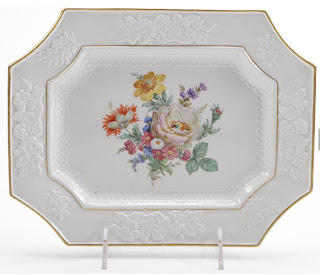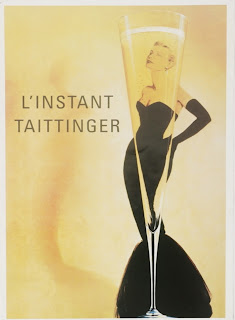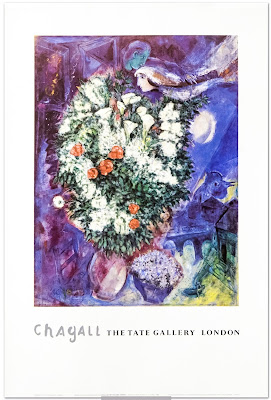Mottahedeh Rare Vintage Lace Cut Dish / Matching Platter hand painted floral 24K
Mottahedeh Rare Vintage Lace Cut Dish / Matching Platter hand painted floral 24K
 The ceramics are indeed beautiful - beautiful fakes. But Mildred Mottahedeh, the energetic, 80-year-old collector of Chinese export porcelains whose company produces these museum-quality reproductions, would cross swords with anyone who chose to employ such a disparaging term. Fake indeed. Good reproductions insure that works of art will be preserved for future generations.
The ceramics are indeed beautiful - beautiful fakes. But Mildred Mottahedeh, the energetic, 80-year-old collector of Chinese export porcelains whose company produces these museum-quality reproductions, would cross swords with anyone who chose to employ such a disparaging term. Fake indeed. Good reproductions insure that works of art will be preserved for future generations.
 ''The originals are just too valuable to use,'' Mrs. Mottahedeh (pronounced MOT-teh-heh-dah) said recently as she guided an interviewer on a tour of the Mottahedeh & Company showroom at 225 Fifth Avenue, between 26th and 27th Streets, in Manhattan. ''They get broken. Light-fingered people make off with them.'' But even the reproductions are picked off as mementos, said Clement Conger, the curator who assembled a vaunted collection of fine furniture, paintings and china for the elegant suite of diplomatic reception rooms at the State Department. ''We used to use two sizes of some nice Chinese export trays, but they would slowly but surely disappear,'' he said. ''Now we just use the big ones because they are too large to slip into the pocket.''
''The originals are just too valuable to use,'' Mrs. Mottahedeh (pronounced MOT-teh-heh-dah) said recently as she guided an interviewer on a tour of the Mottahedeh & Company showroom at 225 Fifth Avenue, between 26th and 27th Streets, in Manhattan. ''They get broken. Light-fingered people make off with them.'' But even the reproductions are picked off as mementos, said Clement Conger, the curator who assembled a vaunted collection of fine furniture, paintings and china for the elegant suite of diplomatic reception rooms at the State Department. ''We used to use two sizes of some nice Chinese export trays, but they would slowly but surely disappear,'' he said. ''Now we just use the big ones because they are too large to slip into the pocket.''
 Mildred Root Mottahedeh began collecting Japanese prints at the age of 13 after she moved to New York from Rumson, N.J., where she was born. ''And then I met my husband, who was a collector,'' she said. ''And we collected together. We were just two collecting nuts.'' She and her Iranian-born husband, Rafi Y. Mottahedeh, who died in 1978, opened their own importing business. In 1929, they began acquiring Oriental porcelains, ivories, jades and bronzes, amassing one of the world's finest private collections, some 2,000 pieces. In his foreword to ''China for the West,'' a two-volume book published in 1978 by Sotheby Parke Bernet of London about the Mottahedeh collection, Nelson A. Rockefeller - himself a collector of porcelain - declared it to be ''utterly fabulous, an artistic and cultural treasure without comparison in its field.''
Mildred Root Mottahedeh began collecting Japanese prints at the age of 13 after she moved to New York from Rumson, N.J., where she was born. ''And then I met my husband, who was a collector,'' she said. ''And we collected together. We were just two collecting nuts.'' She and her Iranian-born husband, Rafi Y. Mottahedeh, who died in 1978, opened their own importing business. In 1929, they began acquiring Oriental porcelains, ivories, jades and bronzes, amassing one of the world's finest private collections, some 2,000 pieces. In his foreword to ''China for the West,'' a two-volume book published in 1978 by Sotheby Parke Bernet of London about the Mottahedeh collection, Nelson A. Rockefeller - himself a collector of porcelain - declared it to be ''utterly fabulous, an artistic and cultural treasure without comparison in its field.''
 On the tour of the showroom, Mrs. Mottahedeh pointed out some items that met those criteria. ''This is the bowl President Reagan sent to all heads of state,'' she said of a monteith. ''And all that blue and white is the Historic Charleston series. And this was designed by Pierre L'Enfant for George Washington,'' she added, pointing to a dinner service.
On the tour of the showroom, Mrs. Mottahedeh pointed out some items that met those criteria. ''This is the bowl President Reagan sent to all heads of state,'' she said of a monteith. ''And all that blue and white is the Historic Charleston series. And this was designed by Pierre L'Enfant for George Washington,'' she added, pointing to a dinner service.
 Mrs. Mottahedeh is now designing a collection of majolica for the Smithsonian Institution. ''Look at that,'' she said, pointing to a table set with the turquoise and apple-green pottery. ''Doesn't that make you smile?''
Mrs. Mottahedeh is now designing a collection of majolica for the Smithsonian Institution. ''Look at that,'' she said, pointing to a table set with the turquoise and apple-green pottery. ''Doesn't that make you smile?''
 Over the years she has employed her energy, expertise and talent in a variety of ways: supervising the reproduction of about 1,000 period porcelains for the Nelson Rockefeller collection; revitalizing India's brass industry; creating patterns for Cliveden, Chatsworth and other stately homes of England; designing a plate for President Bush's inauguration.
Over the years she has employed her energy, expertise and talent in a variety of ways: supervising the reproduction of about 1,000 period porcelains for the Nelson Rockefeller collection; revitalizing India's brass industry; creating patterns for Cliveden, Chatsworth and other stately homes of England; designing a plate for President Bush's inauguration.
 Moradabad's workers now make handsome period candlesticks, snuff boxes and inkwells that are sold through Mottahedeh and the Winterthur Museum in Delaware.
Moradabad's workers now make handsome period candlesticks, snuff boxes and inkwells that are sold through Mottahedeh and the Winterthur Museum in Delaware.
The Porcelain Art Of Mottahedeh Knows No Age
By BARBARA GAMAREKIAN
Published: April 6, 1989
AS guests linger over after-dinner coffee at the White House and diplomats sip cocktails across the street at the newly restored Blair House, they are surrounded by what they suppose to be priceless porcelains: glorious Chinese export bowls holding lilies and freesia; olive dishes emblazoned with the American eagle, serving as ashtrays; a classic Tobacco Leaf epergne, filled with fruits and candy.
 The ceramics are indeed beautiful - beautiful fakes. But Mildred Mottahedeh, the energetic, 80-year-old collector of Chinese export porcelains whose company produces these museum-quality reproductions, would cross swords with anyone who chose to employ such a disparaging term. Fake indeed. Good reproductions insure that works of art will be preserved for future generations.
The ceramics are indeed beautiful - beautiful fakes. But Mildred Mottahedeh, the energetic, 80-year-old collector of Chinese export porcelains whose company produces these museum-quality reproductions, would cross swords with anyone who chose to employ such a disparaging term. Fake indeed. Good reproductions insure that works of art will be preserved for future generations. ''The originals are just too valuable to use,'' Mrs. Mottahedeh (pronounced MOT-teh-heh-dah) said recently as she guided an interviewer on a tour of the Mottahedeh & Company showroom at 225 Fifth Avenue, between 26th and 27th Streets, in Manhattan. ''They get broken. Light-fingered people make off with them.'' But even the reproductions are picked off as mementos, said Clement Conger, the curator who assembled a vaunted collection of fine furniture, paintings and china for the elegant suite of diplomatic reception rooms at the State Department. ''We used to use two sizes of some nice Chinese export trays, but they would slowly but surely disappear,'' he said. ''Now we just use the big ones because they are too large to slip into the pocket.''
''The originals are just too valuable to use,'' Mrs. Mottahedeh (pronounced MOT-teh-heh-dah) said recently as she guided an interviewer on a tour of the Mottahedeh & Company showroom at 225 Fifth Avenue, between 26th and 27th Streets, in Manhattan. ''They get broken. Light-fingered people make off with them.'' But even the reproductions are picked off as mementos, said Clement Conger, the curator who assembled a vaunted collection of fine furniture, paintings and china for the elegant suite of diplomatic reception rooms at the State Department. ''We used to use two sizes of some nice Chinese export trays, but they would slowly but surely disappear,'' he said. ''Now we just use the big ones because they are too large to slip into the pocket.'' Mildred Root Mottahedeh began collecting Japanese prints at the age of 13 after she moved to New York from Rumson, N.J., where she was born. ''And then I met my husband, who was a collector,'' she said. ''And we collected together. We were just two collecting nuts.'' She and her Iranian-born husband, Rafi Y. Mottahedeh, who died in 1978, opened their own importing business. In 1929, they began acquiring Oriental porcelains, ivories, jades and bronzes, amassing one of the world's finest private collections, some 2,000 pieces. In his foreword to ''China for the West,'' a two-volume book published in 1978 by Sotheby Parke Bernet of London about the Mottahedeh collection, Nelson A. Rockefeller - himself a collector of porcelain - declared it to be ''utterly fabulous, an artistic and cultural treasure without comparison in its field.''
Mildred Root Mottahedeh began collecting Japanese prints at the age of 13 after she moved to New York from Rumson, N.J., where she was born. ''And then I met my husband, who was a collector,'' she said. ''And we collected together. We were just two collecting nuts.'' She and her Iranian-born husband, Rafi Y. Mottahedeh, who died in 1978, opened their own importing business. In 1929, they began acquiring Oriental porcelains, ivories, jades and bronzes, amassing one of the world's finest private collections, some 2,000 pieces. In his foreword to ''China for the West,'' a two-volume book published in 1978 by Sotheby Parke Bernet of London about the Mottahedeh collection, Nelson A. Rockefeller - himself a collector of porcelain - declared it to be ''utterly fabulous, an artistic and cultural treasure without comparison in its field.''
In 1985, some 400 pieces were sold at Sotheby's, but Mrs. Mottahedeh's apartment in Manhattan and her house in Stamford, Conn., are still chockablock with treasures she rotates from storage. ''I have 18 rooms of things I love up in the country and five rooms of things I love in town,'' she said. ''Even my kitchen has antique porcelain on the walls.''
A privately held company, Mrs. Mottahedeh's ceramics concern does not release its sales figures. But it produces about 1,500 different items for more than 3,000 stores, from Tiffany & Company to small gift shops. The company also reproduces pieces in the collections of museums like the Metropolitan Museum of Art and the Museum of Modern Art in New York, the Dallas Art Institute and the Musee des Art Decoratifs in Paris for sale in their shops. ''But we won't do a piece just because it is historic,'' Mrs. Mottahedeh said. ''It has to have character and usability.''
 On the tour of the showroom, Mrs. Mottahedeh pointed out some items that met those criteria. ''This is the bowl President Reagan sent to all heads of state,'' she said of a monteith. ''And all that blue and white is the Historic Charleston series. And this was designed by Pierre L'Enfant for George Washington,'' she added, pointing to a dinner service.
On the tour of the showroom, Mrs. Mottahedeh pointed out some items that met those criteria. ''This is the bowl President Reagan sent to all heads of state,'' she said of a monteith. ''And all that blue and white is the Historic Charleston series. And this was designed by Pierre L'Enfant for George Washington,'' she added, pointing to a dinner service.
''And here is a reproduction of a Hong bowl that is in the Winterthur collection,'' she went on. ''It is like history in ceramics.'' The elaborately decorated bowl, which sells for $1,750, depicts a series of western hongs, or trading warehouses.
 Mrs. Mottahedeh is now designing a collection of majolica for the Smithsonian Institution. ''Look at that,'' she said, pointing to a table set with the turquoise and apple-green pottery. ''Doesn't that make you smile?''
Mrs. Mottahedeh is now designing a collection of majolica for the Smithsonian Institution. ''Look at that,'' she said, pointing to a table set with the turquoise and apple-green pottery. ''Doesn't that make you smile?''
One of Mottahedeh's most popular designs is based on the Tobacco Leaf pattern originally made in China in the 18th century for export to Portuguese and Brazilian markets. The pattern incorporates 27 colors, with a small phoenix perching on the leaves of a nicotiana. It is used in the board room at Sotheby's in Manhattan and at the American Embassy in London.
''It has a lot of dash and verve,'' Mrs. Mottahedeh said. ''And I make them so they can all go in the dishwasher. The gold won't come off. That is part of my women's movement.''
Mrs. Mottahedeh travels abroad five months a year, checking in at the two dozen manufacturers, primarily in Western Europe, that are contracted to produce her china.
''Darling,'' she explained, ''we have to manufacture abroad. We were a nation of farmers, and we have no tradition of pottery- and porcelain-making in this country. The tradition has to move on from generation to generation. They are even losing it now in England because they only want to do things that can be produced mechanically.''
Mrs. Mottahedeh, who also lectures and writes on the tradition and history of ceramics, wears her four-score years lightly. Like a jack-in-the-box, she jumps up to fetch a book from the next room; then she is off to check out statistics with a staff member; next, she is bustling about in search of a photograph of her great-grandchild, Jamie, to show off.
 Over the years she has employed her energy, expertise and talent in a variety of ways: supervising the reproduction of about 1,000 period porcelains for the Nelson Rockefeller collection; revitalizing India's brass industry; creating patterns for Cliveden, Chatsworth and other stately homes of England; designing a plate for President Bush's inauguration.
Over the years she has employed her energy, expertise and talent in a variety of ways: supervising the reproduction of about 1,000 period porcelains for the Nelson Rockefeller collection; revitalizing India's brass industry; creating patterns for Cliveden, Chatsworth and other stately homes of England; designing a plate for President Bush's inauguration.
''Just look at this,'' she said, picking up a reproduction of a Meissen Swan dinner plate that she produced for Mr. Rockefeller. Noting the original would sell for more than $20,000, she added, ''This one sells for $150.''
In 1954, the Central Indian Handicraft Board in New Delhi asked for her help. She focused on one impoverished city in northern India, Moradabad, where artisans were turning out brass statues ''with 12 pairs of hands and 8 pairs of feet,'' she said, with a wry smile. ''So we gave them three designs to start with and trained them in soldering and metal craft, bringing in big machinery.''
 Moradabad's workers now make handsome period candlesticks, snuff boxes and inkwells that are sold through Mottahedeh and the Winterthur Museum in Delaware.
Moradabad's workers now make handsome period candlesticks, snuff boxes and inkwells that are sold through Mottahedeh and the Winterthur Museum in Delaware.
Mrs. Mottahedeh asserted she had no thoughts of slowing down, and recited her appointments for the day: a 12:30 luncheon, a board meeting, a dinner party. She also planned to review a manuscript over the weekend.
''I'll be 81 in August,'' she said. ''Maybe I'll think about retiring at 90.''





Comments
Post a Comment